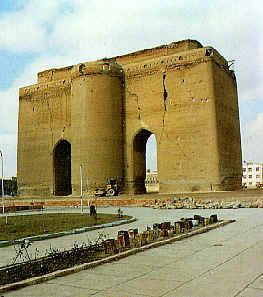Height 28 m | ||
 | ||
Hours Closed now Tuesday8AM–9PMWednesday(Martyrdom of Fatima)8AM–9PMHours might differThursday(Martyrdom of Fatima)8AM–9PMHours might differFriday8AM–9PMSaturday8AM–9PMSunday8AM–9PMMonday8AM–9PM Similar Blue Mosque - Tabriz, Constitution House of Tabriz, Azerbaijan Museum, Saat Tower, Amir Nezam House | ||
Tabriz bazar iran
Arg of Tabriz (Persian: ارگ تبريز, also known as Arg Alishah, Arg-e Alishah, Arch of Alishah, Arg Citadel, and Masjid Ali-Shāh), is the remnants of a big unfinished 14th-century mausoleum and a 19th-century military castle and barrack in city center of Tabriz, Iran.
Contents
- Tabriz bazar iran
- History
- Shelling of Arg by Russian troops 1911
- Destruction During Pahlavi era
- Destruction by revolutionaries early 1980s
- Renovation in recent years 1990s till present days
- References
History
The original construction was made between 1318 and 1339, during the Ilkhanate. Within the construction, the roof of the mausoleum collapsed and the construction was stopped afterward. Centuries later, by the eruption of the Russo-Persian War, 1804-1813, and the Russo-Persian War (1826-1828), the compound was quickly reconstructed as a military compound. During the reconstruction of the Arg compound, a foundry factory for the manufacturing of cannons for the Iranian Army was built, as well as a military headquarter, a barrack for the troops, and a small palace was added as well to the original plan of the Arg. Samson Makintsev, better known as Samson Khan, a Qajar Iranian general of Russian origin, lived inside the citadel for years together with his wife, the daughter of Prince Aleksandre of Georgia.
Shelling of Arg by Russian troops, 1911
During the Russian invasion of Tabriz in 1911 they shelled the Arg in initial attacks. Once they captured the city, they used the Arg as a central command center. During their occupation, because of careless handling, the artillery pieces they used set fire on parts of Arg.
Destruction During Pahlavi era
During the Pahlavi era, parts of the Arg which had been constructed in the 19th century by the Qajar dynasty, were destroyed. This destruction was with the aim of purifying the original Arg construction from later developments. The southern part of the Arg was turned to a park, the "Mellat Garden" (lit. park of the people), before the Iranian revolution in 1979.
Destruction by revolutionaries, early 1980s
In the early 1980s after the suppression of uprising of supporters of Muslim People's Republic Party against the new establishment of mixing religion and state and neglecting of Azerbaijani minorities, Moslem Malakuti selected as new Imam Juma of Tabriz by the revolutionary government. During his tenure in Tabriz the destruction of Ark's Qajar era addendum wall and cultural institutes and ark theater surrounding it accomplished and a new mosque for Friday prayers. Some people believe this destruction of local heritage was a systematic destruction of local Azerbaijani identity.
Renovation in recent years, 1990s till present days
In the 1990s and 2000s, a rehabilitation and renovation project was executed by the Iranian Organization for Cultural Heritages. During this rehabilitation, however, all of the remaining Qajar era development from Arg castle were destroyed. At the same period, a new big mosque was built next to the Arg castle. The superstructure of the new mosque undermine the architecture of Arg castle. Despite the regulations of the Iranian Organization for Cultural Heritages and several court hearing the construction of the new structure continued and accomplished.
